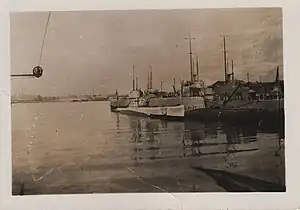 | |
| History | |
|---|---|
| Name | HMS H43 |
| Builder | Armstrong Whitworth, Newcastle Upon Tyne |
| Laid down | 4 October 1917 |
| Launched | 3 February 1919 |
| Commissioned | 25 November 1919 |
| Fate | Sold for scrapping, November 1944 |
| General characteristics | |
| Class and type | H class submarine |
| Displacement |
|
| Length | 171 ft 0 in (52.12 m) |
| Beam | 15 ft 4 in (4.67 m) |
| Propulsion |
|
| Speed |
|
| Range |
|
| Complement | 22 |
| Armament |
|
HMS H43 was a British H class submarine built by Armstrong Whitworth, Newcastle Upon Tyne. She was laid down on 4 October 1917 and was commissioned on 25 November 1919. It had a complement of twenty-two crew members.
HMS H43 was one of the seven H class submarines to survive to the end of World War II . HMS H43 was sold in November 1944 and was scrapped in Troon in 1945.
Design
Like all post-H20 British H-class submarines, H43 had a displacement of 423 long tons (430 t) at the surface and 510 long tons (520 t) while submerged.[1] It had a total length of 171 feet (52 m),[2] a beam of 15 feet 4 inches (4.67 m), and a draught of 12 metres (39 ft).[3] It contained a diesel engines providing a total power of 480 horsepower (360 kW) and two electric motors each providing 320 horsepower (240 kW) power.[3] The use of its electric motors made the submarine travel at 11 knots (20 km/h; 13 mph). It would normally carry 16.4 long tons (16.7 t) of fuel and had a maximum capacity of 18 long tons (18 t).[4]
The submarine had a maximum surface speed of 13 knots (24 km/h; 15 mph) and a submerged speed of 10.5 knots (19.4 km/h; 12.1 mph). Post-H20 British H-class submarines had ranges of 2,985 nautical miles (5,528 km; 3,435 mi) at speeds of 7.5 knots (13.9 km/h; 8.6 mph) when surfaced.[1][3] H43 was fitted with an anti-aircraft gun and four 21 inches (530 mm) torpedo tubes. Its torpedo tubes were fitted to the bows and the submarine was loaded with eight 21 inches (530 mm) torpedoes.[1] It is a Holland 602 type submarine but was designed to meet Royal Navy specifications. Its complement was twenty-two crew members.[1]
Operational use
- July 1940 delivered Lt. Hubert Nicholle to German occupied Guernsey to undertake a reconnaissance and successfully recovered him 3 days later. Commanded by Lt Colvin.[5]
See also
References
- 1 2 3 4 Gardiner, Robert; Gray, Robert (1985). Conway's All the World's Fighting Ships 1906-1921. London: Conway Maritime Press. p. 92. ISBN 0-85177-245-5.
- ↑ Derek Walters (2004). The History of the British 'U' Class Submarine. Casemate Publishers. pp. 2–. ISBN 978-1-84415-131-8.
- 1 2 3 Colledge, J. J.; Warlow, Ben (2006) [1969]. Ships of the Royal Navy: The Complete Record of all Fighting Ships of the Royal Navy (Rev. ed.). London: Chatham Publishing. ISBN 978-1-86176-281-8. Retrieved from Naval-History on 20 August 2015.
- ↑ J. D. Perkins (1999). "Building History and Technical Details for Canadian CC-Boats and the Original H-CLASS". Electric Boat Company Holland Patent Submarines. Retrieved 20 August 2015.
- ↑ Jackson, Robert (20 March 2013). Churchill's Channel War 1939-45. Osprey Publishing, 2013. ISBN 9781472801319.
Bibliography
- Hutchinson, Robert (2001). Jane's submarines : war beneath the waves from 1776 to the present day. London: HarperCollins. ISBN 978-0007105588.